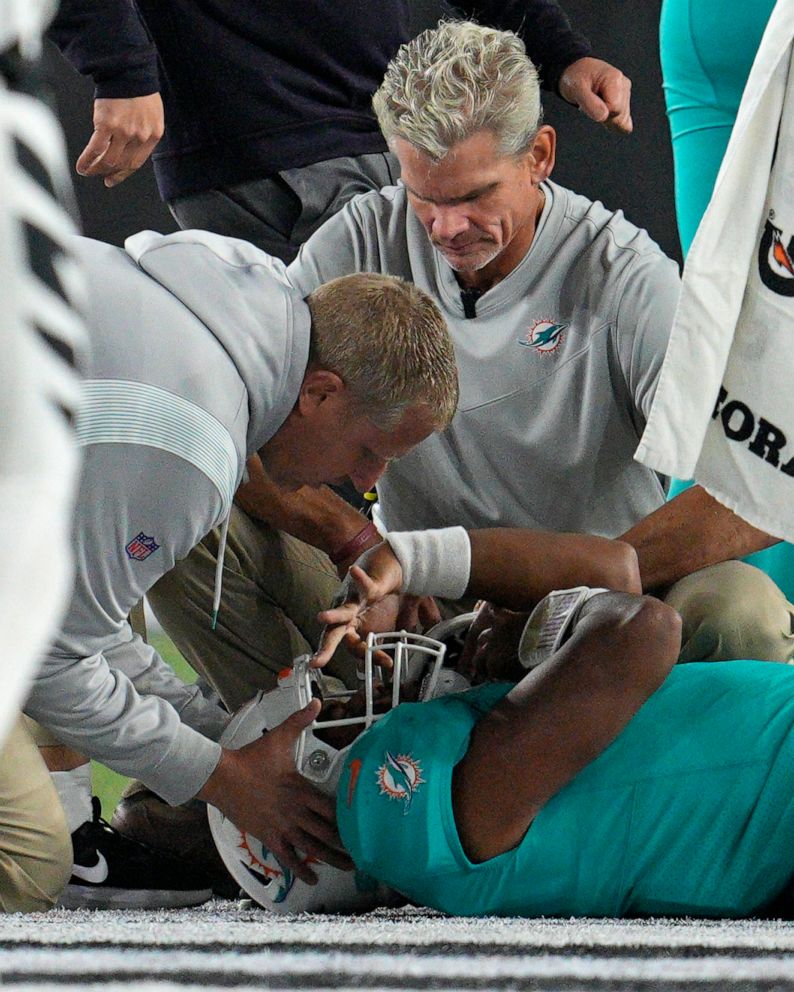
Jeff Dean/AP, ABC News, https://abcnews.go.com/Sports/nfl-fire-concussion-protocol-tua-tagovailoas-back-back/story?id=90918691
Here is NFL QB Tua Tagovailoa being attended to by the Miami Dolphins medical staff while unconscious after being slammed on the back of his head when being tackled, later the whole staff were fired due to controversy over the handling of Tua and his multiple concussions.
In conclusion, I have found that following the NFL lawsuit of 2012 news media both regional and national took a turn on how they discussed NFL injuries. The purpose of this research was to see if there was any change and how overall I would say that is a success. Using purposive and convenience sampling the news media published in the years before the 2012 lawsuit tended to take injuries more lightly and attack the players who are injured, then after the lawsuit there was a switch to take injuries much more seriously as well as shifting the verbal attacks onto the management of the NFL. Regional sources seemed to have much more freedom with how they presented injuries using comedic relief or insulting players was much more common in regional sources before 2012. After 2012 I found that these more local sources had more freedom to attack both the league and the teams in their handling of injuries.
The injury that produced the most backlash or attacks was traumatic brain injury or concussions as they are more commonly known. Through scholarly research of many people such as Wayment and Huffman (2018) that many players feel that serious and potentially life altering brain injuries see injuries as a natural part of football. This viewpoint is common among articles before 2012 but after 2012 there was a shift in news media framing of such injuries. As a result people view injuries and more specifically concussions.
Through past research of people such as Karimipour and Hull (2017) I found that there are many different terms, phrases, and ways to frame injuries. I have found through my research that some articles will rely on insults, some will rely on the trope of masculinity, and some even rely on humor to frame the messages. After 2012, I found it was more common for journalists to frame their articles scientifically or with medical evidence to back up their perspective but some still relied on insults or anger normally directed at the NFL as a league about their mishandling of injuries. I even found evidence in the news of serious doubt or a lack of trust in the NFL and how they handle injuries after 2012.
Past research has investigated the politics and demographic identities on perception of injuries in news media. Many researchers such as Hawkins (2021) researched how age affects how people view concussions, while I did not find many instances of that I did find a difference in regional vs national news media and how they perceive injuries. Other researchers look at how the player’s race can affect how the injury is being viewed. I found little evidence to back this in my research. I also found that there was no mention of race, and going off of this I found that no matter what the race of the player they were equally likely to be bashed or disliked in media for their injuries before 2012 and supported and worried about much more after 2012.
The answer to my research question about how perceptions on injuries have changed since the 2012 lawsuit, the blame or hate has shifted from player to organization. There were many instances of players being demeaned since 2012 for injuries that did not get the same reaction in the news after 2012 from the news. I also found that news media have presented injuries without the overly masculine football stereotypes. Though this is not always the case there clearly have been significant strides in the right direction towards a much safer future for NFL players and football players nationwide and now that the sport is growing globally.
If I was to sit down and do more research on this topic of perceptions on injuries I would like to take a look at twitter for a better understanding of the public’s reactions. Through social context theory we can predict how the public will act but if I had more time I always wanted to look at twitter but found it would be too much. Another avenue I think would be interesting to explore are interviews with players specifically and even player podcasts as many former NFL players have started podcasts about their careers.